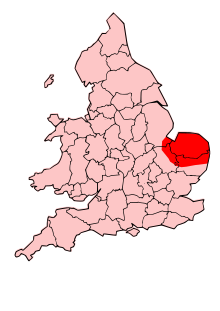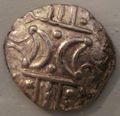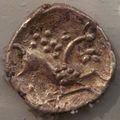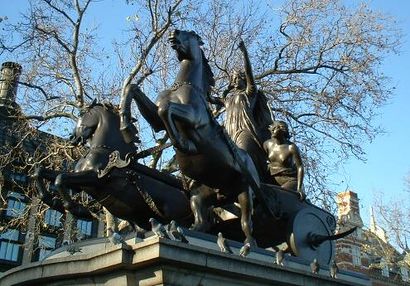إيكني
| Iceni | |
|---|---|
 | |
| الجغرافيا | |
| العاصمة | ڤنتا إيكنورم (كيستور سانت إدموند) |
| الموقع | نورفوك سفوك -فنز لنكنشاير جنوب هولاند -فنز كمبردجشاير Fenland، شرق كمبردجشاير -AKA الفنز |
| الحكام | Canduro[...], Aesu[...], Saemu[...], Antedi[...] پراسوتاگوس بوديكا |
إيكني (Iceni ؛ /aɪˈsiːnaɪ/؛ eye-SEEN-eye؛ اللاتينية الفصحى: [ɪˈkeːniː]) أو إكني Eceni كانوا قبيلة بريتونية في شرق بريطانيا أثناء العصر الحديدي ومطلع العصر الروماني. أرضهم ضمت نورفوك الحالية وأجزاء من سفوك وكمبردجشاير، وجاورت منطقة Corieltauvi إلى الغرب، و Catuvellauni و Trinovantes إلى الجنوب. في الفترة الرومانية، كانت عاصمتهم ڤنتا إيكنورم في كيستور سانت إدموند الحالية.[1][2]
يوليوس قيصر لا يذكر الإيكني في كتابه غزوات بريطانيا في 55 و 54 ق.م.، بالرغم من أنهم قد يكونوا مرتبطين بالـ كنيماگني، الذين لاحظ قيصر أنهم يعيشون شمال نهر التيمز في ذلك الوقت. كان الإيكني قوة معتبرة في شرق بريطانيا أثناء فتح بريطانيا بقيادة كلاوديوس في 43م، الذي تحالفوا فيه مع روما. تزايد التأثير الروماني على أمورهم أدى إلى الثورة في 47م، بالرغم من أنهم بقوا اسمياً مستقلين تحت قيادة الملك پراسوتاگوس حتى وفاته حوالي 60م. الإحاطة الرومانية بعد وفاة پراسوتاگوس أدى أرملته بوديكا لشن ثورة كبرى من 60–61. هددت انتفاضة بوديكا بشكل خطير الحكم الروماني في بريطانيا وأسفرت عن حرق لوندينيوم ومدن أخرى. وأخيراً تمكن الرومان من سحق التمرد، وتم دمج الإيكني بشكل أكبر في المقاطعة الرومانية.[1][2]
الاسم
The meaning of the name Iceni (لاتينية: Icēnī) is uncertain. In his 1658 treatise "Hydriotaphia, or Urn Burials", الإنگليزي متعدد المواهب توماس براون claims that the Iceni got their name from the Iken, the old name for the River Ouse, where the Iceni were said to have originated.[3] Robert Henry (1771) refers to a suggested naming from the Brittonic word ychen meaning oxen.[4] Ych (s.) and Ychen (pl.) are still used in modern Welsh.[5]
Icenian coins dating from the 1st century AD use the spelling ECEN:[6] another article by D. F. Allen titled “The Coins of the Iceni,” discusses the difference between coins with the inscription ECE versus coins with ECEN. This difference, Allen posits, tells archaeologists and historians when Prasutagus started his reign because the coins did not start reading the name of the tribe until around AD 47. Allen suggests that when Antedios was king of the Iceni, the coins did not yet have the name of the tribe on them but instead the name of its ruler, stating, "If so, the coins suggest that the Prasutagus era commenced only after the events of 47" (Allen 16).[7]
الآثار
عملات برونزية للإيكني. متحف لندن.
الغزو الروماني
Tacitus records that the Iceni were not conquered in the Claudian invasion of AD 43, but had come to a voluntary alliance with the Romans. However, they rose against them in 47 after the governor, Publius Ostorius Scapula, threatened to disarm them. D. F. Allen explains in further detail, in his article "The Coins of the Iceni," that Scapula had been "preoccupied with defense against the unconquered Silures in South Wales and Brigantes in Yorkshire." Allen informs readers that this was how Prasutagus had come to gain full control over the Iceni (Allen 2). The Iceni were defeated by Ostorius in a fierce battle at a fortified place, but were allowed to retain their independence.[8] The site of the battle may have been Stonea Camp in Cambridgeshire.
بقاء محتمل في الفنز
In the Life of Saint Guthlac – a biography of the East Anglian hermit who lived in the Fens during the early 8th century – it is stated that Saint Guthlac was attacked on several occasions by people he believed were Britons living in the Fens at that time. However, Bertram Colgrave, in the introduction to one edition, doubts it because of the lack of evidence of British survival in the region and the fact that British place names in the area are "very few".[بحاجة لمصدر]
رواية
- Henty, George (1893). Beric of Britain: A story of the Roman Invasion. London.
{{cite book}}: Cite has empty unknown parameter:|coauthors=(help)CS1 maint: location missing publisher (link)
المراجع
- ^ أ ب Ó Faoláin, Simon (2006). "Iceni". In Koch, John T. (ed.). Celtic Culture: A Historical Encyclopedia. ABC-CLIO. pp. 954–955. ISBN 1851094407. Retrieved December 18, 2015.
- ^ أ ب Snyder, Christopher A. (2003). The Britons. Blackwell Publishing. pp. 34–36, 40–42. ISBN 0-631-22260-X.
- ^ "Hydriotaphia: Chapter II".
- ^ Henry, Robert (1771). The History of Great Britain. London: T.Cadell. p. 176.
- ^ A Dictionary of the Welsh Language. University of Wales. 2017.
- ^ Perkins, C H. "Celtic Coinage".
- ^ Britannia, Vol. 1, Society for the Promotion of Roman Studies, 1970
- ^ Tacitus, Annals 12.31
ببليوگرافيا
- Allen, D. F. "The Coins of the Iceni." Britannia (1970): 1-33. Web. 12 March 2013.
- Bunson, Matthew. “Britannia.” Encyclopedia of the Roman Empire. New York: Facts on File, 1994. Print.
- Bunson, Matthew. “Iceni.” Encyclopedia of Ancient Rome. 3rd Ed. New York: Facts On File, 2012. Print.
- “Britain, Roman.” The Oxford Classical Dictionary. 4th ed. Oxford: Oxford UP, 2012. Print.
- Davies, John. A., Gregory, Tony. "Coinage from a 'Civitas': A Survey of the Roman Coins Found in Norfolk and their Contribution to the Archaeology of the 'Civitas Icenorum'" "Britannia" (1991): 65-101. Web. 12 March 2013.
- Dio, Cassius. Roman History :. Cambridge: Harvard UP, 1987. Print.
- Gardiner, Juliet, and Neil Wenborn. “Civitas.” The Columbia Companion to British History. New York: Columbia UP, 1997. Print.
- Mossop, H. R. and Allen, D. F. "The Elusive Icenian Legend." Britannia (1979): 258-259. Web. 12 March 2013.
- Williamson, Tom. The Origins of Norfolk. Manchester University Press: 1993.
وصلات خارجية
- Pages using gadget WikiMiniAtlas
- Pages with plain IPA
- Articles containing لاتينية-language text
- Pages using Lang-xx templates
- Articles with unsourced statements from June 2018
- CS1 maint: location missing publisher
- Coordinates on Wikidata
- شعوب كلتية تاريخية
- البريتون الكلت
- تاريخ نورفوك
- آثار نورفوك
- إيكني
- قبائل هزمتها روما





